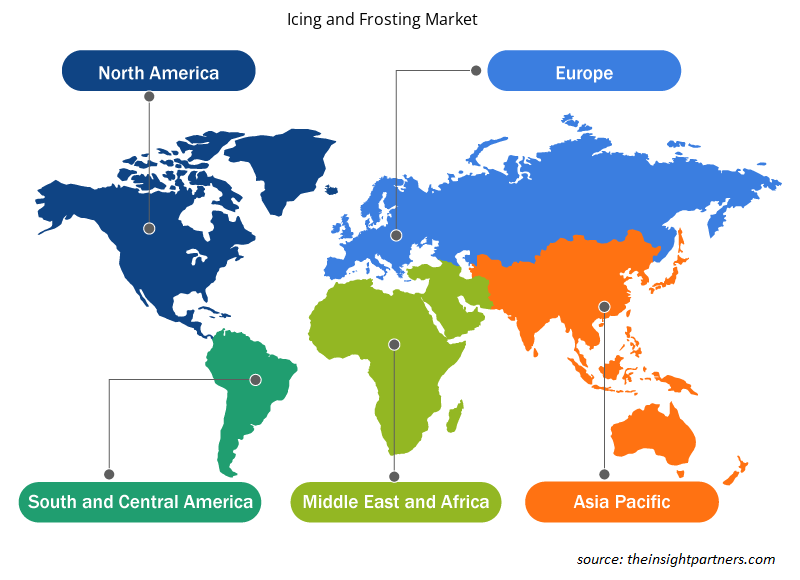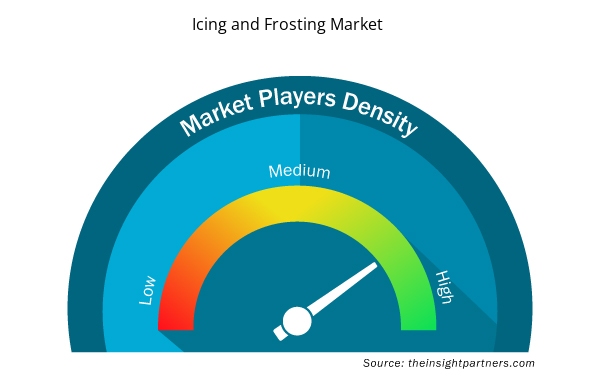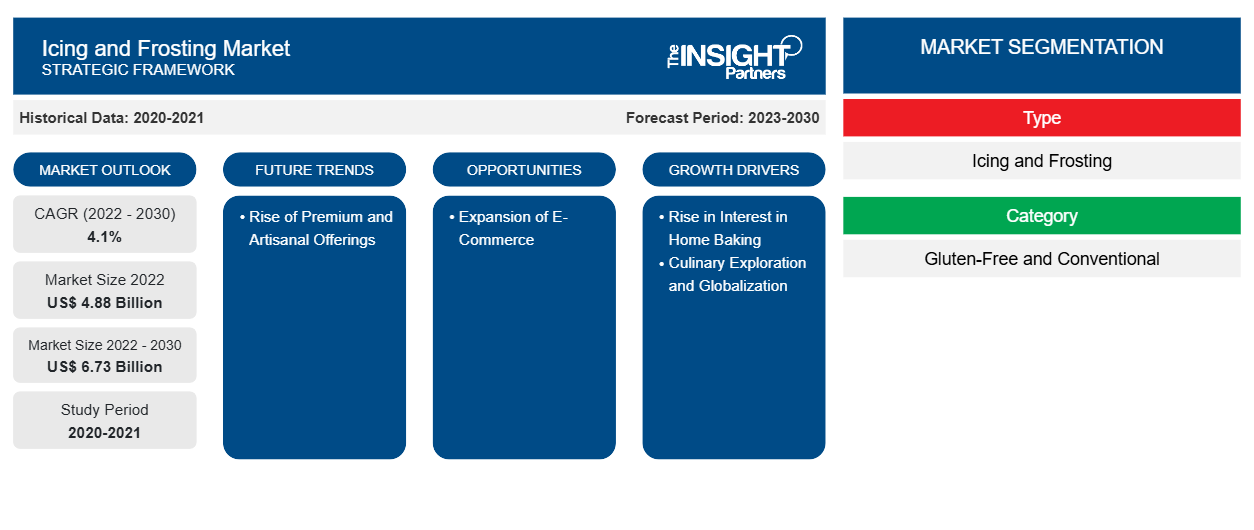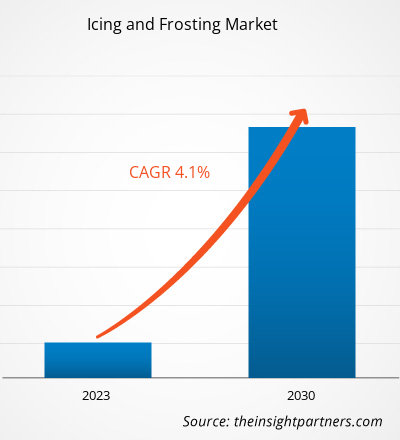[研究报告] 2022 年糖霜和糖霜市场价值为 48.8315 亿美元,预计到 2030 年将达到 67.3 亿美元;预计 2022-2030 年期间的复合年增长率为 4.1%。
市场分析
糖霜和糖霜是零售行业中烘焙原料中一个充满活力的部分,因为它们被广泛用于装饰蛋糕、糕点和其他烘焙食品并为其增添风味。随着全球消费者群体对美味零食和特色甜点的兴趣日益浓厚,糖霜和糖霜市场也见证了稳步扩张,而这得益于城市化、消费者生活方式的改变以及家庭烘焙的流行等因素。产品细分包括奶油和皇家糖霜等传统选择,以及翻糖和奶油奶酪糖霜等较新的创新产品,可满足各种口味和偏好。分销渠道多种多样,从超市、便利店、特色面包店到在线零售平台,反映了消费者多样化的购物习惯。
近年来,由于注重健康的消费者寻求更清洁、更透明的配料,人们对天然和有机糖霜和糖霜产品的需求不断增长。这导致了以植物为基础的替代品、天然甜味剂(如枫糖浆或蜂蜜)和传统乳制品糖霜制成的产品的发展。此外,社交媒体和烘焙节目的兴起也导致人们对烘焙食品独特且视觉上有吸引力的装饰的需求日益增长。消费者寻求定制和个性化的糖霜和糖霜选择,为提供创意设计和可食用印花的专业公司创造了机会。
糖霜和糖霜市场规模不断扩大的主要因素是人们对家庭烘焙的兴趣日益浓厚,以及烹饪探索和全球化。烹饪探索和全球化促进了对超越传统界限的多样化、异国风味的需求。食品偏好的全球化导致人们更多地接触来自世界各地的各种烹饪影响。随着消费者在口味偏好上变得大胆,对烘焙食品中独特和国际风味的需求也日益增长。这种全球烹饪探索直接影响了糖霜和糖霜市场规模,消费者寻求能够反映不同口味和质地融合的创新和优质选择。
许多社会的多元文化构成促成了对满足各种文化偏好的糖霜和糖霜的需求。随着来自不同文化背景的人互动并分享烹饪经验,人们对符合特定文化品味的产品的需求日益增加。这种趋势在糖霜和糖霜市场中显而易见,制造商正在推出一系列受各种美食启发的口味,以吸引多样化的消费者群体。注重提供满足不同文化口味的产品推动了糖霜和糖霜市场的创新。
世界各地都有优质和异国风味的原料,这促进了糖霜和糖霜市场风味的全球化。消费者越来越多地寻求采用全球采购的独特优质原料的产品。这促使制造商探索各种异国风味和质地,为糖霜和糖霜带来一定程度的精致,以满足从事烹饪探索的消费者的挑剔口味。全球原料的融合满足了对独特风味的需求,并提高了糖霜和糖霜市场产品的质量。
增长动力与挑战
烹饪探索和全球化促进了对超越传统界限的多样化、异国风味的需求。食品偏好的全球化导致人们更多地接触来自世界各地的各种烹饪影响。随着消费者在口味偏好方面变得大胆,对烘焙食品中独特和国际风味的需求也日益增长。这种全球烹饪探索直接影响了糖霜和糖霜市场,消费者寻求能够反映出不同口味和质地融合的创新和优质选择。
许多社会的多元文化构成促成了对满足各种文化偏好的糖霜和糖霜的需求。随着来自不同文化背景的人互动并分享烹饪经验,人们对符合特定文化品味的产品的需求日益增加。这种趋势在糖霜和糖霜市场中显而易见,制造商正在推出一系列受各种美食启发的口味,以吸引多样化的消费者群体。注重提供满足不同文化口味的产品推动了糖霜和糖霜市场的创新。
定制此报告以满足您的需求
您可以免费定制任何报告,包括本报告的部分内容、国家级分析、Excel 数据包,以及为初创企业和大学提供优惠和折扣
- 获取此报告的关键市场趋势。这个免费样品将包括数据分析,从市场趋势到估计和预测。
报告分类和范围
“全球糖霜和糖霜市场分析”通过考虑类型、类别、分销渠道和地理等细分市场进行。该报告提供了全球糖霜和糖霜使用情况的关键统计数据,以及主要地区和国家的需求情况。此外,该报告还对影响主要地区和国家市场表现的因素进行了定性评估。它还包括对市场主要参与者及其关键战略发展的全面分析。还包括对市场动态的分析,以帮助确定糖霜和糖霜市场趋势、关键驱动因素和有利可图的机会,从而有助于创造更高的收入。
生态系统分析和波特五力分析提供了全球糖霜和糖霜市场的360度视角,有助于了解整个供应链和影响糖霜和糖霜市场增长的各种因素。
节段分析
市场根据类型、类别、分销渠道和地理位置进行细分。根据类型,市场分为糖霜和糖霜。糖霜部分占有较大的糖霜和糖霜市场份额。糖霜是一种甜味奶油状的顶料,常用于烘焙食品。它与糖霜相似,但在成分和质地上有一些差异。它通常更厚更蓬松,侧重于创造一种光滑易涂抹的稠度。糖霜含有糖粉、黄油、起酥油和香草或巧克力等调味料。与可能具有更液体或釉状稠度的糖霜不同,糖霜往往更坚固,常用于装饰蛋糕、纸杯蛋糕和其他甜点。
人们对自制美食和创意烹饪体验的渴望推动了家庭烘焙的日益流行,这也导致对方便且多功能糖霜选择的需求增加。此外,传统电视和流媒体平台上的烘焙节目也激发了人们尝试不同的糖霜技术以获得专业效果。生日和庆祝活动等活动推动了家庭烘焙食品定制和个性化的需求,这增加了对多样化和风味糖霜品种的需求。流行的糖霜类型有奶油霜、奶油奶酪糖霜和甘纳许,每种糖霜都为各种甜点应用提供了独特的口味和质地。
区域分析
该报告详细概述了全球糖霜和糖霜市场,涉及五大主要地区——北美、欧洲、亚太地区 (APAC)、中东和非洲 (MEA) 以及南美和中美洲。亚太地区占据全球糖霜和糖霜市场的最大份额,2022 年该地区的市场价值约为 11.9 亿美元。预计到 2030 年,欧洲市场将达到约 20.9 亿美元。预计北美市场在预测期(2022 年至 2030 年)的复合年增长率约为 3%。在亚太地区,糖霜和糖霜需求的激增受到文化转变、消费者口味不断变化的以及西式甜点日益流行的多种影响。在许多亚洲国家,随着可支配收入的增加,中产阶级人口也在增加。这种人口结构的变化增加了人们对优质和奢华食品体验的兴趣,包括用漂亮和美味的糖霜装饰的烘焙食品。随着生活方式越来越富裕,人们对自制、外观精美和美味甜点的需求不断增长,推动了该地区糖霜和糖霜市场的增长。此外,食品趋势的全球化,尤其是西方美食的影响,极大地影响了亚太地区消费者的偏好。
糖霜和糖霜市场区域洞察
Insight Partners 的分析师已详尽解释了预测期内影响糖霜和糖霜市场的区域趋势和因素。本节还讨论了北美、欧洲、亚太地区、中东和非洲以及南美和中美洲的糖霜和糖霜市场细分和地理位置。

- 获取糖霜和糖霜市场的区域特定数据
糖霜和糖霜市场报告范围
| 报告属性 | 细节 |
|---|---|
| 2022 年市场规模 | 48.8亿美元 |
| 2030 年的市场规模 | 67.3亿美元 |
| 全球复合年增长率(2022 - 2030 年) | 4.1% |
| 史料 | 2020-2021 |
| 预测期 | 2023-2030 |
| 涵盖的领域 | 按类型
|
| 覆盖地区和国家 | 北美
|
| 市场领导者和主要公司简介 |
|
糖霜和糖霜市场参与者密度:了解其对业务动态的影响
糖霜和糖霜市场正在快速增长,这得益于终端用户需求的不断增长,而这些需求又源于消费者偏好的不断变化、技术进步以及对产品优势的认识不断提高等因素。随着需求的增加,企业正在扩大其产品范围,进行创新以满足消费者的需求,并利用新兴趋势,从而进一步推动市场增长。
市场参与者密度是指在特定市场或行业内运营的企业或公司的分布情况。它表明在给定市场空间中,相对于其规模或总市场价值,有多少竞争对手(市场参与者)存在。
在糖霜和糖霜市场运营的主要公司有:
- 威尔顿品牌有限公司
- 通用磨坊公司
- 康尼格拉品牌公司
- 欧特家博士(英国)有限公司
- 迪克西蛋糕及更多公司
免责声明:上面列出的公司没有按照任何特定顺序排列。

- 获取糖霜和糖霜市场顶级关键参与者概述
竞争格局和主要公司
Wilton Brands LLC、General Mills Inc、Conagra Brands Inc、Dr. Oetker (UK) Ltd、Dixie's Cakes and More Inc、Cake Craft Factory LLC、The Pillsbury Co LLC、Rich Products Corp、The Purple Mixer Inc 和 The Simple Kitchen Oakville Inc 是糖霜和糖霜市场报告中介绍的知名企业。此外,在研究过程中还研究和分析了其他几家企业,以全面了解市场及其生态系统。糖霜和糖霜市场报告还包括公司定位和集中度,以评估市场中竞争对手/参与者的表现。
行业发展和未来机遇
糖霜和糖霜市场主要参与者采取的举措如下:
- 2022 年,邓肯·海因斯 (Duncan Hines) 与生日派对项目合作,为有需要的孩子们度过更甜蜜的生日。
- 2022 年,邓肯·海因斯 (Duncan Hines) 将与全球超级明星多莉·帕顿 (Dolly Parton) 合作,为餐桌带来新的南方风格甜点
- 历史分析(2 年)、基准年、预测(7 年)及复合年增长率
- PEST 和 SWOT 分析
- 市场规模价值/数量 - 全球、区域、国家
- 行业和竞争格局
- Excel 数据集


- Fill Finish Manufacturing Market
- Smart Parking Market
- Neurovascular Devices Market
- Emergency Department Information System (EDIS) Market
- Arterial Blood Gas Kits Market
- Wind Turbine Composites Market
- Virtual Event Software Market
- Non-Emergency Medical Transportation Market
- Helicopters Market
- Europe Surety Market

Report Coverage
Revenue forecast, Company Analysis, Industry landscape, Growth factors, and Trends

Segment Covered
This text is related
to segments covered.

Regional Scope
North America, Europe, Asia Pacific, Middle East & Africa, South & Central America

Country Scope
This text is related
to country scope.
常见问题
Based on category, the icing and frosting market is bifurcated into gluten-free and conventional. The demand for conventional icing and frosting remains strong due to its timeless appeal and versatility in enhancing the flavor and presentation of a wide range of baked goods. Traditional icing and frosting recipes typically include powdered sugar, butter, and flavorings, creating a rich and creamy texture. The continuing popularity of classic desserts such as birthday cakes, cupcakes, and cookies has sustained the demand for these conventional toppings. Additionally, the continued growth of the baking industry, both commercially and in home kitchens, contributes to the surge in demand. Consumers often gravitate toward familiar and comforting flavors, and the accessibility of conventional icing and frosting recipes allows for easy customization and creativity in decorating various baked treats. The popularity of these time-tested options is further fueled by the joy and nostalgia of indulging in beautifully frosted desserts.
In 2022, Asia Pacific dominated the global icing and frosting market share. In Asia Pacific, the upsurge in demand for icing and frosting is influenced by a combination of cultural shifts, evolving consumer tastes, and the growing popularity of Western-style desserts. There is a rise in the middle-class population with increasing disposable income in many Asian countries. This demographic shift has increased interest in premium and indulgent food experiences, including baked goods decorated with beautiful and flavorful icing. As lifestyles become more affluent, the demand for home-baked, visually appealing, and gourmet desserts has expanded, driving the icing and frosting market growth in the region. Additionally, the globalization of food trends, particularly the influence of Western cuisine, has significantly shaped consumer preferences in Asia Pacific.
The growing interest in home baking has emerged as a significant driver for the icing and frosting market, catalyzing the demand for diverse, high-quality products. The rise of home baking is intricately tied to a broader cultural shift toward culinary creativity and do-it-yourself experiences. Inspired by popular baking shows and online tutorials, consumers are increasingly taking up baking as a recreational activity. This has led to a surge in demand for premium icing and frosting as home bakers seek to enhance their homemade treats' visual appeal and flavor complexity. Moreover, the therapeutic and stress-relieving aspects of home baking have contributed to the surge in interest. Many individuals turned to baking for relaxation and creative expression during lockdowns and social distancing. This surge in baking as a therapeutic hobby has translated into a heightened demand for icing and frosting, as consumers aim to create visually appealing and indulgent desserts to share with family and friends. The desire for an enjoyable and fulfilling baking experience has driven consumers to explore various icing options, including unique flavors and decorative techniques. The influence of social media platforms has played a pivotal role in the rising interest in home baking and, consequently, the demand for icing and frosting. The sharing culture on platforms such as Instagram and Pinterest has fueled a desire for aesthetically pleasing baked goods. Home bakers are motivated to experiment with different icing techniques to create visually stunning treats worthy of sharing online. This social media-driven trend has created a demand for premium and innovative icing products as consumers seek to replicate or create unique, shareable desserts.
Based on type, the market is segmented into icing and frosting. The frosting segment holds a larger icing and frosting market share. Frosting is a sweet and creamy topping commonly used on baked goods. It is similar to icing but has some differences in ingredients and texture. It is often thicker and fluffier, focusing on creating a smooth and spreadable consistency. Frosting contains powdered sugar, butter, shortening, and flavorings such as vanilla or chocolate. Unlike icing, which may have a more liquid or glaze-like consistency, frosting tends to be more substantial and is often used for decorating cakes, cupcakes, and other desserts.
The major players operating in the global icing and frosting market are Wilton Brands LLC, General Mills Inc, Conagra Brands Inc, Dr. Oetker (UK) Ltd, Dixie's Cakes and More Inc, Cake Craft Factory LLC, The Pillsbury Co LLC, Rich Products Corp, The Purple Mixer Inc, and The Simple Kitchen Oakville Inc among others.
The rise of premium and artisanal offerings is anticipated to be a notable trend in the icing and frosting market, reflecting a shift in consumer preferences toward more sophisticated and high-quality products. Consumers increasingly value craftsmanship and authenticity in their culinary experiences, seeking premium ingredients and artisanal techniques. This trend is particularly evident in the icing and frosting market, where the emphasis on handcrafted, small-batch products has gained traction. Home bakers and consumers alike are drawn to the allure of unique flavors, textures, and visual appeal offered by premium and artisanal icing options.
The demand for premium and artisanal offerings is closely linked to the desire for a more indulgent and sophisticated baking experience. As consumers seek to elevate their homemade treats to a higher culinary standard, there is a growing interest in icing and frosting that go beyond basic functionality. Premium options often include unique flavor profiles, such as exotic extracts, high-quality chocolates, and natural ingredients, providing consumers with a more refined and indulgent palette. The trend of premium and artisanal offerings aligns with the broader movement of consumers viewing baking as a form of self-expression and creativity.
Trends and growth analysis reports related to Food and Beverages : READ MORE..
The List of Companies - Icing and Frosting Market
- Wilton Brands LLC
- General Mills Inc
- Conagra Brands Inc
- Dr. Oetker (UK) Ltd
- Dixie's Cakes and More Inc
- Cake Craft Factory LLC
- The Pillsbury Co LLC
- Rich Products Corp
- The Purple Mixer Inc
- The Simple Kitchen Oakville Inc
The Insight Partners performs research in 4 major stages: Data Collection & Secondary Research, Primary Research, Data Analysis and Data Triangulation & Final Review.
- Data Collection and Secondary Research:
As a market research and consulting firm operating from a decade, we have published and advised several client across the globe. First step for any study will start with an assessment of currently available data and insights from existing reports. Further, historical and current market information is collected from Investor Presentations, Annual Reports, SEC Filings, etc., and other information related to company’s performance and market positioning are gathered from Paid Databases (Factiva, Hoovers, and Reuters) and various other publications available in public domain.
Several associations trade associates, technical forums, institutes, societies and organization are accessed to gain technical as well as market related insights through their publications such as research papers, blogs and press releases related to the studies are referred to get cues about the market. Further, white papers, journals, magazines, and other news articles published in last 3 years are scrutinized and analyzed to understand the current market trends.
- Primary Research:
The primarily interview analysis comprise of data obtained from industry participants interview and answers to survey questions gathered by in-house primary team.
For primary research, interviews are conducted with industry experts/CEOs/Marketing Managers/VPs/Subject Matter Experts from both demand and supply side to get a 360-degree view of the market. The primary team conducts several interviews based on the complexity of the markets to understand the various market trends and dynamics which makes research more credible and precise.
A typical research interview fulfils the following functions:
- Provides first-hand information on the market size, market trends, growth trends, competitive landscape, and outlook
- Validates and strengthens in-house secondary research findings
- Develops the analysis team’s expertise and market understanding
Primary research involves email interactions and telephone interviews for each market, category, segment, and sub-segment across geographies. The participants who typically take part in such a process include, but are not limited to:
- Industry participants: VPs, business development managers, market intelligence managers and national sales managers
- Outside experts: Valuation experts, research analysts and key opinion leaders specializing in the electronics and semiconductor industry.
Below is the breakup of our primary respondents by company, designation, and region:

Once we receive the confirmation from primary research sources or primary respondents, we finalize the base year market estimation and forecast the data as per the macroeconomic and microeconomic factors assessed during data collection.
- Data Analysis:
Once data is validated through both secondary as well as primary respondents, we finalize the market estimations by hypothesis formulation and factor analysis at regional and country level.
- Macro-Economic Factor Analysis:
We analyse macroeconomic indicators such the gross domestic product (GDP), increase in the demand for goods and services across industries, technological advancement, regional economic growth, governmental policies, the influence of COVID-19, PEST analysis, and other aspects. This analysis aids in setting benchmarks for various nations/regions and approximating market splits. Additionally, the general trend of the aforementioned components aid in determining the market's development possibilities.
- Country Level Data:
Various factors that are especially aligned to the country are taken into account to determine the market size for a certain area and country, including the presence of vendors, such as headquarters and offices, the country's GDP, demand patterns, and industry growth. To comprehend the market dynamics for the nation, a number of growth variables, inhibitors, application areas, and current market trends are researched. The aforementioned elements aid in determining the country's overall market's growth potential.
- Company Profile:
The “Table of Contents” is formulated by listing and analyzing more than 25 - 30 companies operating in the market ecosystem across geographies. However, we profile only 10 companies as a standard practice in our syndicate reports. These 10 companies comprise leading, emerging, and regional players. Nonetheless, our analysis is not restricted to the 10 listed companies, we also analyze other companies present in the market to develop a holistic view and understand the prevailing trends. The “Company Profiles” section in the report covers key facts, business description, products & services, financial information, SWOT analysis, and key developments. The financial information presented is extracted from the annual reports and official documents of the publicly listed companies. Upon collecting the information for the sections of respective companies, we verify them via various primary sources and then compile the data in respective company profiles. The company level information helps us in deriving the base number as well as in forecasting the market size.
- Developing Base Number:
Aggregation of sales statistics (2020-2022) and macro-economic factor, and other secondary and primary research insights are utilized to arrive at base number and related market shares for 2022. The data gaps are identified in this step and relevant market data is analyzed, collected from paid primary interviews or databases. On finalizing the base year market size, forecasts are developed on the basis of macro-economic, industry and market growth factors and company level analysis.
- Data Triangulation and Final Review:
The market findings and base year market size calculations are validated from supply as well as demand side. Demand side validations are based on macro-economic factor analysis and benchmarks for respective regions and countries. In case of supply side validations, revenues of major companies are estimated (in case not available) based on industry benchmark, approximate number of employees, product portfolio, and primary interviews revenues are gathered. Further revenue from target product/service segment is assessed to avoid overshooting of market statistics. In case of heavy deviations between supply and demand side values, all thes steps are repeated to achieve synchronization.
We follow an iterative model, wherein we share our research findings with Subject Matter Experts (SME’s) and Key Opinion Leaders (KOLs) until consensus view of the market is not formulated – this model negates any drastic deviation in the opinions of experts. Only validated and universally acceptable research findings are quoted in our reports.
We have important check points that we use to validate our research findings – which we call – data triangulation, where we validate the information, we generate from secondary sources with primary interviews and then we re-validate with our internal data bases and Subject matter experts. This comprehensive model enables us to deliver high quality, reliable data in shortest possible time.


 获取此报告的免费样本
获取此报告的免费样本